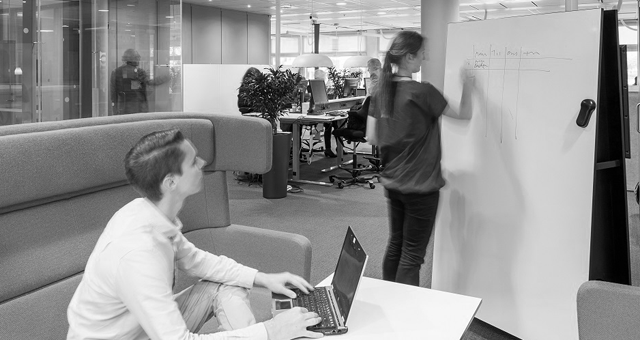
What is the value of the office
One out of every two employees doesn’t think their office enables them to work productively. Kati Barklund, Innovation Manager of Workplace Services at Coor Service Management, sees enormous potential in the offices of the future.
A word from our expert
Why do we need novel office solutions?
“The primary purpose of an office is to support the people who work in it, providing them with the right conditions to be able to do a good job. Our work has changed a lot in recent years, but generally, offices haven’t adapted. Nowadays, we’re also moving from a focus on workspace efficiency and savings, to also viewing offices as a strategic tool for attracting people, and not least, helping our people to become more prosperous, committed and productive. A good office can enhance attractivity and productivity, but efficiency and sustainability too. Coor’s new smart office model brings a holistic lifestyle perspective to the workplace. We take an overall approach to the workplace, and ensure that the solution remains good over time.”
More and more companies and other organizations are introducing activity-based workplaces. How’s it going for them?
“A lot of them are doing well, but we also have clients who contact us after introducing activity-based workplaces because they haven’t achieved the desired outcomes. Usually this is because their change process hasn’t succeeded, or quite simply, they haven’t put enough emphasis on it. Sometimes, the process has been run as a design or relocation project, rather than a change process. This is probably the most common mistake companies make—they view their workplace as a project instead of as a process. Those companies who have succeeded with their offices and have employees who are satisfied and perform well over time, understand that workplace is an ongoing process. They have built flexibility into their offices, and they monitor the office continuously and adapt it to changing needs.”
”It’s also common to forget to adapt the office services you’ll need and to grab it first when the office is ready. If this planning process can be conducted in parallel with office design, there’s great potential to optimize premises and support services.”
The primary purpose of an office is to support the people that work in it, providing them with the right potential to do a good job.
What will we demand from the offices of the future?
"They’ll need to be attractive, productive, efficient and sustainable. The office should be a meeting place, so the employees need to want to be there. Research indicates that our view of workplaces doesn’t differ notably from generation to generation. However, we conduct different activities, and need to adapt our office to these activities. The clearest trend we’re currently seeing is collaboration—that we have to cooperate cross-border. In a large organization, this collaboration is across unit boundaries, but doesn’t stop there. In innovative organizations, open innovation—sharing our experiences and creating collectively—are the algorithm of the future. No company can afford to conduct technology development on its own any more, for example. Everything is becoming more open, and the substantial values are realized when we share our experiences and let other people help. At Coor, we apply an innovation ecosystem that utilizes partners in specific segments. We contribute our experience and unique customer perspective, while other partners bring technological no-how, such as on our project involving sensors in the workplace.”
Those activities we do today—will we do them tomorrow?
Quite often, companies proceed from the old behaviors, trying to adapt them to the new conditions. This doesn’t work. Rather, we need to be aware of our current behaviors and habits so we can change them actively. Everyone knows it’s good to work standing up, but most people still work sitting down. Companies need to truly work out the changes they want to achieve. At Coor’s offices, we’ve got help from our cleaners to raise the level of all desks during evening hours. We remind everyone that it’s good to stand up, so it’s easier to make standing a habit. We’ve also built in movement into our offices—there’s thought behind everyone having to walk a bit to pick up some fruit or dispose of waste, for example.
“Generally, people don’t like change. We know how things are now, but we don’t know how things will be after the change. My advice is to visit other companies and workplaces to gain inspiration and see how good things can be. Then, it’s important to proceed from your own strategy, vision, goals and challenges, and adapt your office to them. To ask why we’re doing this? All companies face challenges they have to focus on, and they have to identify those challenges. For example, do we need to be more attractive, more productive or more efficient? The subsequent process is also critical. You need a governance model, to follow up and adapt your office. In fact, it’s all very simple—we proceed from our needs, focus on our people and the activities that must be conducted. Then things go right.”

